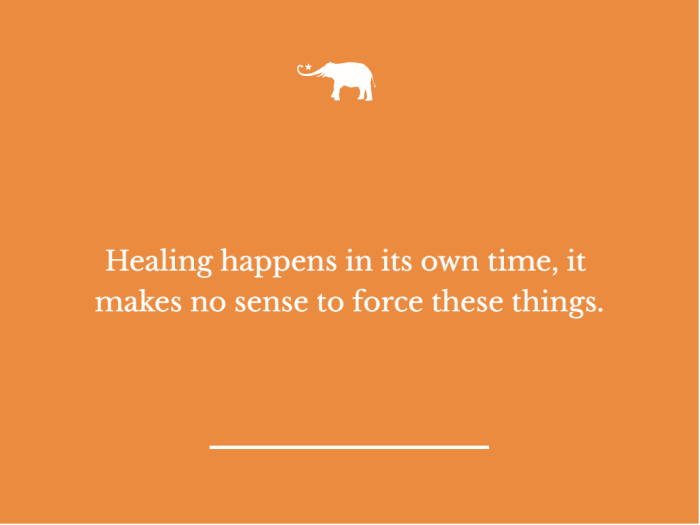Within the blink of an eye my absolute biggest fear and worst nightmare became reality. I heard the devastating news and lost it. Lost the ground under my feet, my words, my mind, myself. Sarah as she had been – gone.
So here I am four years later, writing up a small collection out of the thousand things that I’ve learned from an experience that destroyed parts of me and changed how I used to relate to the world. Suicide survivors often experience complicated grief, which can be multi-layered with long-lasting symptoms, such as intrusive thoughts, and sleeplessness, just to name a few. It sent me off into years of walking through very dark terrains and in some of them I’d put up camp for some time.
1. Dissociation is not all bad. During the first few weeks after the event, dissociation saved my life. Dissociation is a way in which our brain takes care of us when things get overwhelming, simply too challenging to cope with. It helped to disengage from the world when she got too loud, it numbed me when the pain was unbearable and it slowed down quick reactions following triggers, which otherwise could have resulted in a lot of damage. The brain finds ways to keep us safe when it feels unsafe to simply ‘be’ in this physical world. So, when a survivor feels like they are wrapped in bubble tape and the environment sounds far away, it’s a normal response to abnormal circumstances. However, ongoing dissociating can slow down or prevent recovery from the impact of trauma. In that case it is helpful to seek support through different therapies such as, bodywork, breathwork, Yoga and/or traditional talk therapy. Of course, there are more options, and we chose whatever works best for us. Kind reminder that we are all different in our needs and responses to adverse life situations.
2. Losing someone to suicide is the quickest inventory on people in your life. People’s reactions to trauma, grief, and loss vary – a lot. It’s common that people don’t know what to say after a suicide and some responses can be hurtful. A distant relative called the morning after I had flown on a red eye from Australia to my family home in Europe, crying my eyes out and my soul to sleep for about 20 hours. The reason for the phone call had been the following – no, not the unbelievable tragedy that had just happened to us – they had planned to go on a holiday in the following week to a destination nearby and they would be “forced to postpone” that. There wasn’t an expression of grief or compassion or interest in our wellbeing, which we would kind of expect from, let’s say, any decent person. I did send them on their holiday, and we didn’t invite them to the funeral. The point here is, there is no need to spend energy on those kinds of people. So, we sort those people out, gone. In our case also – see you never again. And you know what? That’s okay, because the survivor needs to focus all their energy on themselves, their survival and then their Reconciliation of some sort can be possible in the future if we wish, allowing the time and space we need.
3. Healing is possible. Healing happens in its own time, it makes no sense to force these things. So when we feel the time is right it is beneficial to actively support our healing. I have tried many different therapies from Somatic Experiencing to Equine Therapy and many in between, but the one consistent tool for healing to me, was and is Yoga. Trauma-sensitive Yoga is different and can be boring for people with a non-traumatised nervous system, but deeply healing to people who had adverse life experiences. It is a practice led by choice, Ahimsa (non-violence) and no pressure to achieve a particular outcome. Attending non-trauma informed Yoga classes can be challenging and provoke emotional reactions for which a traditional Yoga teacher may not be equipped. We can google if there are trauma-informed practitioners in our area and see if someone’s practice resonates with us. There is also always the option of an online arrangement if there is no one nearby. Online treatment also works in a grief circle setting or for traditional therapies as it happens from the comfort of our own home and may therefore feel much safer to us.
4. Love will find its way back into your perception when you let it. After I had returned to Australia for a little while, a beautiful little creature tippy toed her way into my life and my heart. Peta. A stray cat, grey and white with green eyes. She moved in and I surrendered. Peta helped me to learn how to care again for something that has a heartbeat. She helped my heart to slowly open again. To my surprise I realised, I wasn’t completely gone. And that’s what happens – love will find its way to us in unconventional ways sometimes. Peta opened my eyes to the world around me that was filled with so much love and support from amazing friends, family, and colleagues. They helped to remember parts of me that I had forgotten about and to slowly piece Sarah back together. Not the same but made new out of the old. So, my final message here is – love will be there for us, whenever we are ready.












Read 0 comments and reply